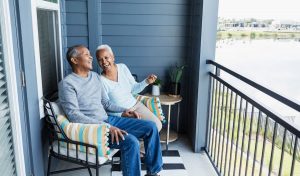 Because many seniors spend most of their time at home, it’s no surprise that’s where most falls happen. Regardless of whether they live in an apartment, house, or elsewhere, there are some key changes you and your older loved ones can implement for elderly fall prevention. Serenity Home Care, a comprehensive home care agency licensed by the Oregon Health Authority, offers several ways to optimize and safeguard an elderly family member’s home.
Because many seniors spend most of their time at home, it’s no surprise that’s where most falls happen. Regardless of whether they live in an apartment, house, or elsewhere, there are some key changes you and your older loved ones can implement for elderly fall prevention. Serenity Home Care, a comprehensive home care agency licensed by the Oregon Health Authority, offers several ways to optimize and safeguard an elderly family member’s home.
Eliminate Tripping Hazards
The first step to fall-proofing a home is to remove all evident tripping hazards. Examine the home’s commonly used pathways and check the floors for hazards like:
- Throw rugs or small area rugs
- Uneven transitions between rooms
- Slippery hardwood, linoleum, or tile
- Loose corners or ripples in carpeting
- Piles of belongings or clutter left on the floor
- Electric cords and wires that cross the pathway
When you identify a hazard, eliminate it. For instance, hardware stores sell no-slip strips for tile or hardwood, while a carpet specialist can secure any loose corners or bulges.
Enhance Stairway Safety
Many seniors struggle with stairs. With limited mobility and reduced strength, the typical residential stairway can become difficult and even dangerous. Of course, not every senior can live in a home without staircases. If the home includes a second story, here are some tips to make the stairway safer:
- Install handrails on both sides of the stairs. If there are already handrails, make sure they are tightly fastened and strong enough to bear your loved one’s weight.
- Ensure that the whole stairway is well-lit. There should also be functional light switches at both the top and the bottom of the stairs.
- Check the stairs for uneven surfaces, loose carpet, jagged corners, or slippery steps, and install new flooring or no-slip strips as necessary.
- Look into products like stair lifts that enable seniors to safely sit in a chair while the device transports them up and down the staircase.
Make Bed and Bath Adjustments
The bedroom and bathroom are frequently used throughout the day and night, so it’s vital to ensure they don’t present risks that would contribute to falls. Consider making these adjustments:
- Mount grab bars near toilets and on both the inside and outside of the tub or shower.
- Place non-slip mats or strips on surfaces that may get wet.
- Install night lights to enhance your loved one’s visibility in the dark.
- Put a light switch or lamp close to the bed, where it can be reached easily without standing.
- Store all clothing, hygiene items, and other belongings in easy-to-reach locations.
Check the Home’s Furniture
Finally, check the furniture throughout the home. You should ensure that all furniture – especially low pieces like coffee tables – are out of the way of walking paths, where they might trip someone moving through the home. Also make sure that sofas, chairs, and beds are easy to get out of. If a chair or sofa is too low or high for comfort, then it should be replaced.
Seek Professional Advice
If you still aren’t comfortable with your elderly loved one’s at-home safety, contact a professional. Serenity Home Care employs an experienced team of compassionate caregivers who can advise on elderly fall protection and provide the support seniors need to thrive at home. Get in touch today to learn more about elderly fall prevention and our services for Multnomah, Clackamas, and Washington Counties, OR.




